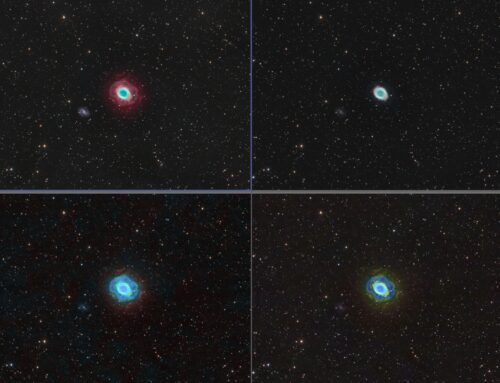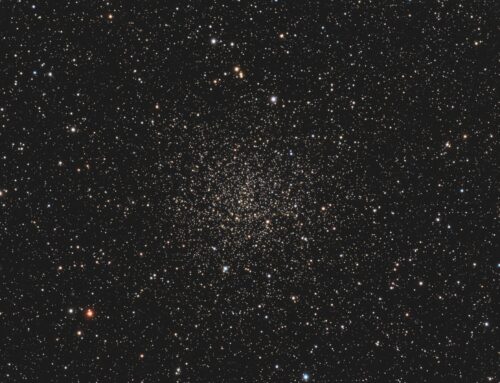Sh2-54 Emission Nebula Wide Field
 Click image for full size version
Click image for full size version
August 2, 2017
Sharpless 54 (Sh2-54) is the brightest patch in this image. This region rarely gets imaged because it is so close to other iconic objects like the Eagle Nebula, the Swan Nebula and the Trifid Nebula, not to mention all the other nearby gems in the summer Milky Way. In fact, Sh2-54 and the Eagle Nebula are part of the same H(II) region that lies about 7,000 light years away in Serpens and Sagittarius, and also contains the Lagoon Nebula (M8). The Eagle would be just “below” this field of view.
Sh2-54 contains many protostars and young stars, which cause it to glow more brightly than the surrounding gas.Below Sh2-54 in this image is open cluster NGC 6604. It is a little closer, at around 5,500 light years, and contains some hot, young, white stars.
Tekkies:
Moravian G3-16200 EC camera (on loan from O’Telescope), Optolong Ha, R, G and B filters, Takahashi FSQ-106 ED IV at f/3.6, Paramount MX, unguided. Acquisition with the SkyX, focused with FocusMax. All pre-processing and processing in PixInsight. Acquired from my SkyShed in Guelph. Gibbous to full moon for Ha, new to crescent moon for RGB, average transparency and poor seeing.
15x5m R, 16x5m G, 17x5m B and 26x10m Ha unbinned frames (total=8hr20m).
NB-RGB Creation:
Creation and cleanup: The BatchPreProcessing script was used to perform calibration, cosmetic correction and registration of all frames. DrizzleIntegration was used to make the channel masters. The R, G, B and Ha masters were cropped to remove edge artifacts. R, G and B were combined to make an RGB image which was processed with DBE, BackgroundNeutralization and ColorCalibration.
Combining Ha and RGB data: The NBRGBCombination script was run with default settings using Ha for red narrowband . BackgroundNeutralization and ColorCalibration were applied.
Linear Noise Reduction: MultiscaleLinearTransform was used to reduce noise in the NB-RGB image. Layer settings for threshold and strength: Layer 1: 3.5 0.8 Layer 2: 3.0, 0.6 Layer 3: 2., 0.51 Layer 4: 1.0, 0.2 Layer 5: 0.5, 0.1.
Stretching: HistogramTransformation was applied to the NB-RGB image to make a pleasing, bright image.
Synthetic Luminance:
Creation and cleanup of SynthL: The linear Ha, R, G and B masters were combined using the ImageIntegration tool (average, additive with scaling, noise evaluation, iterative K-sigma / biweight midvariance, no pixel rejection). Deconvolution: A star mask was made to use as a local deringing support image. A copy of the image was stretched to use as a range mask. Deconvolution was applied (50 iterations, regularized Richardson-Lucy, external PSF made using DynamicPSF tool with about 30 stars).Linear Noise Reduction: MultiscaleLinearTransform was used to reduce noise in the background areas of the NB-RGB file. Layer settings for threshold and strength: Layer 1: 3.5 0.6 Layer 2: 3.0, 0.5 Layer 3: 2., 0.4 Layer 4: 1.0, 0.2 Layer 5: 0.5, 0.1.
Stretching: HistogramTransformation was applied to the SynthL to make a pleasing, bright image.
Noise Reduction and Re-Stretch: TGVDenoise was applied in Lab mode with 300 iterations with a range mask applied to protect high signal areas. This was followed by a HistogramTransformation to raise the black point (but with no clipping).
Combining SynthL with NB-RGB:
The processed SynthL was applied to the NB-RGB image using LRGBCombine.
Additional Processing:
Contrast Enhancement: The contrast was boosted with two passes of LocalHistogramEqualization with max contrast of 1.5 (scale 50, strength 0.65 and scale 150, strength 0.2) using a mask to protect background and stars. The mask was made by making a very blurred range mask with the RangeSelection tool and a star mask with the StarMask tool, and then using PixelMath to subtract the star mask from the range mask without rescaling.
Final Steps: MultiscaleLinearTransform was used to sharpen the structures in the bright parts of the nebulae (layers 2-4 at 0.05). Background, nebula and star brightness, contrast and saturation were adjusted in several iterations using Curves with masks as required. Stars were reduced in size using the Morphological Selection mode of the MorphologicalTransformation tool.
Image scale is about 1.6 arcsec per pixel for this camera/telescope combination and Drizzle processing.






Leave A Comment